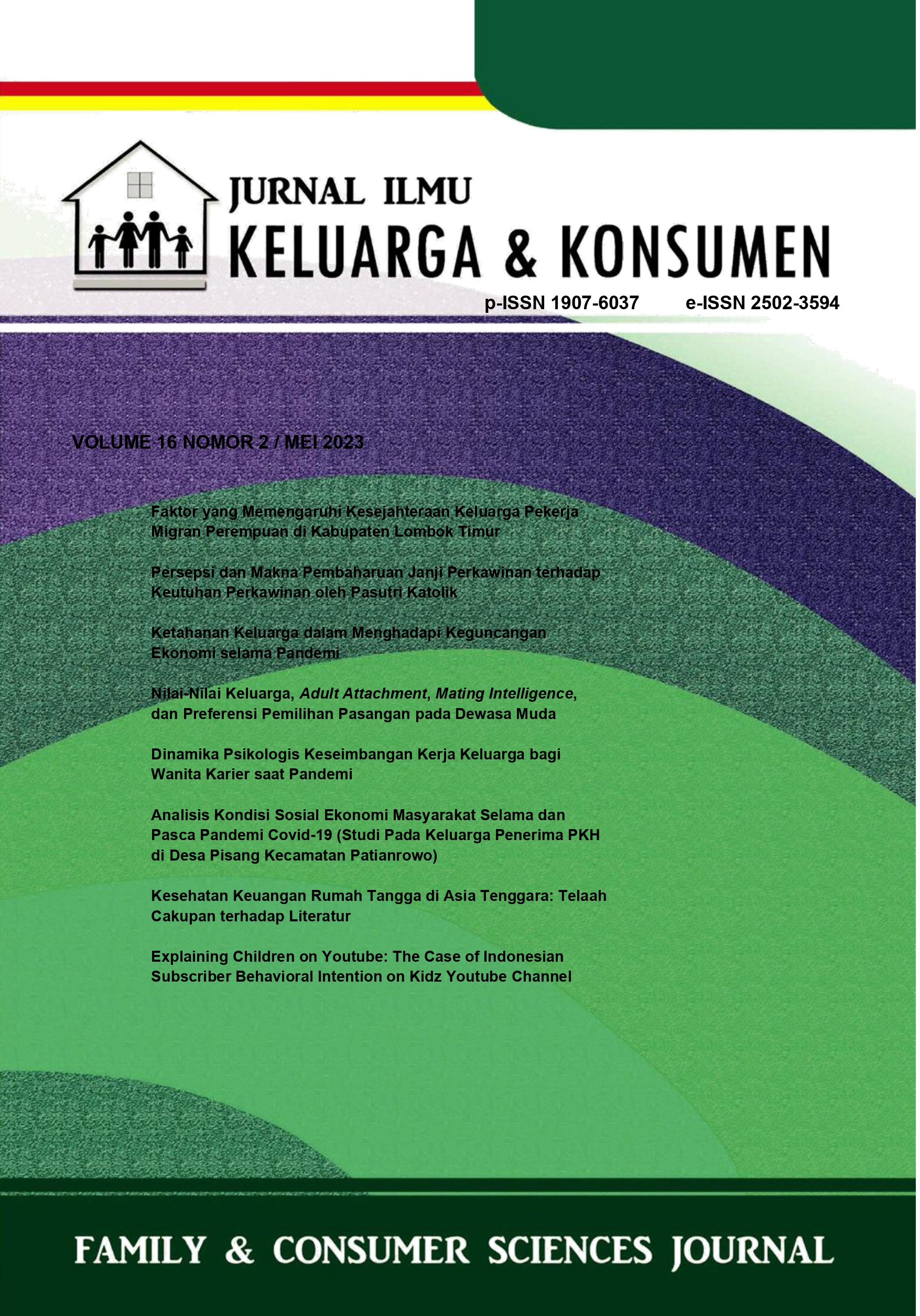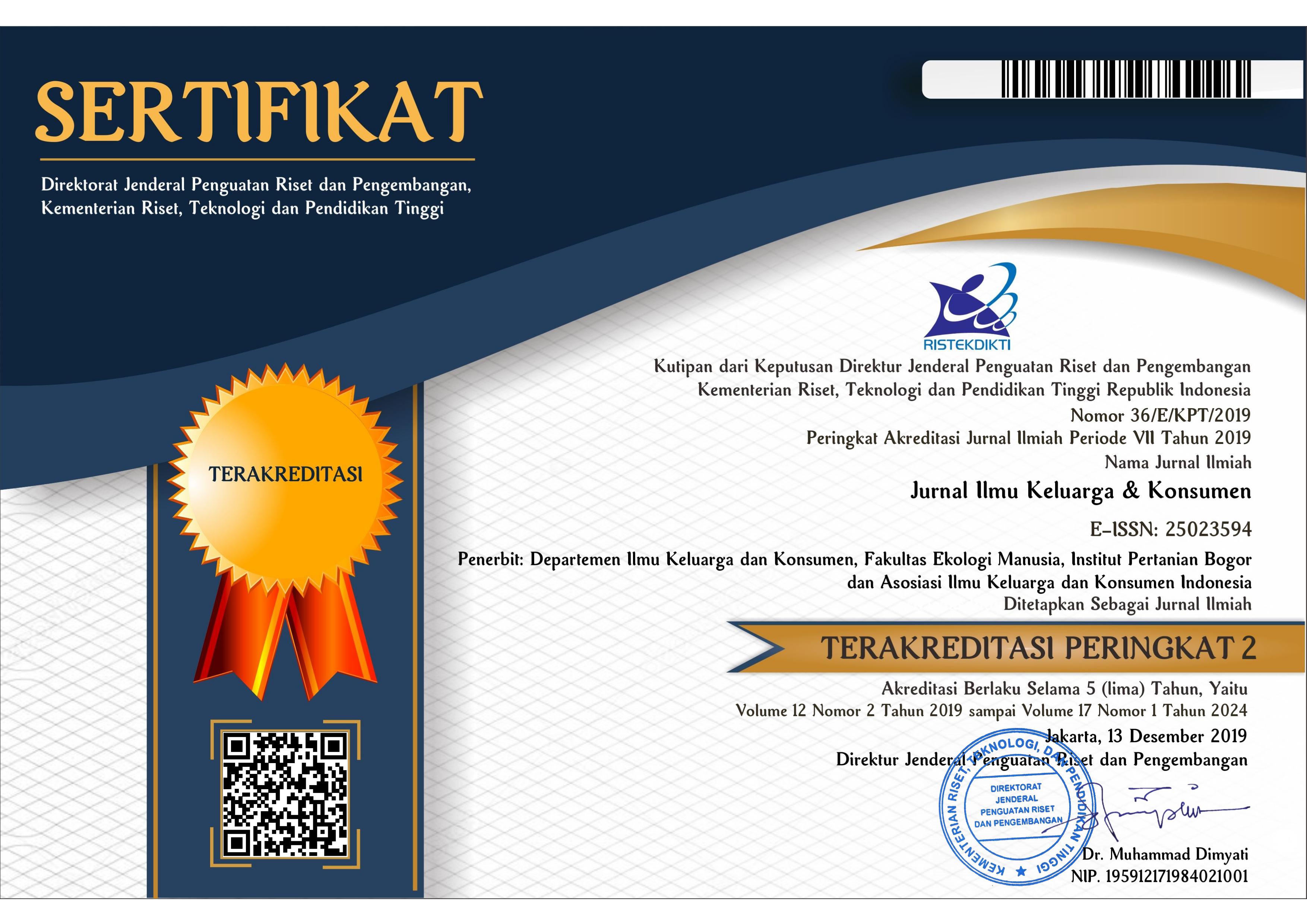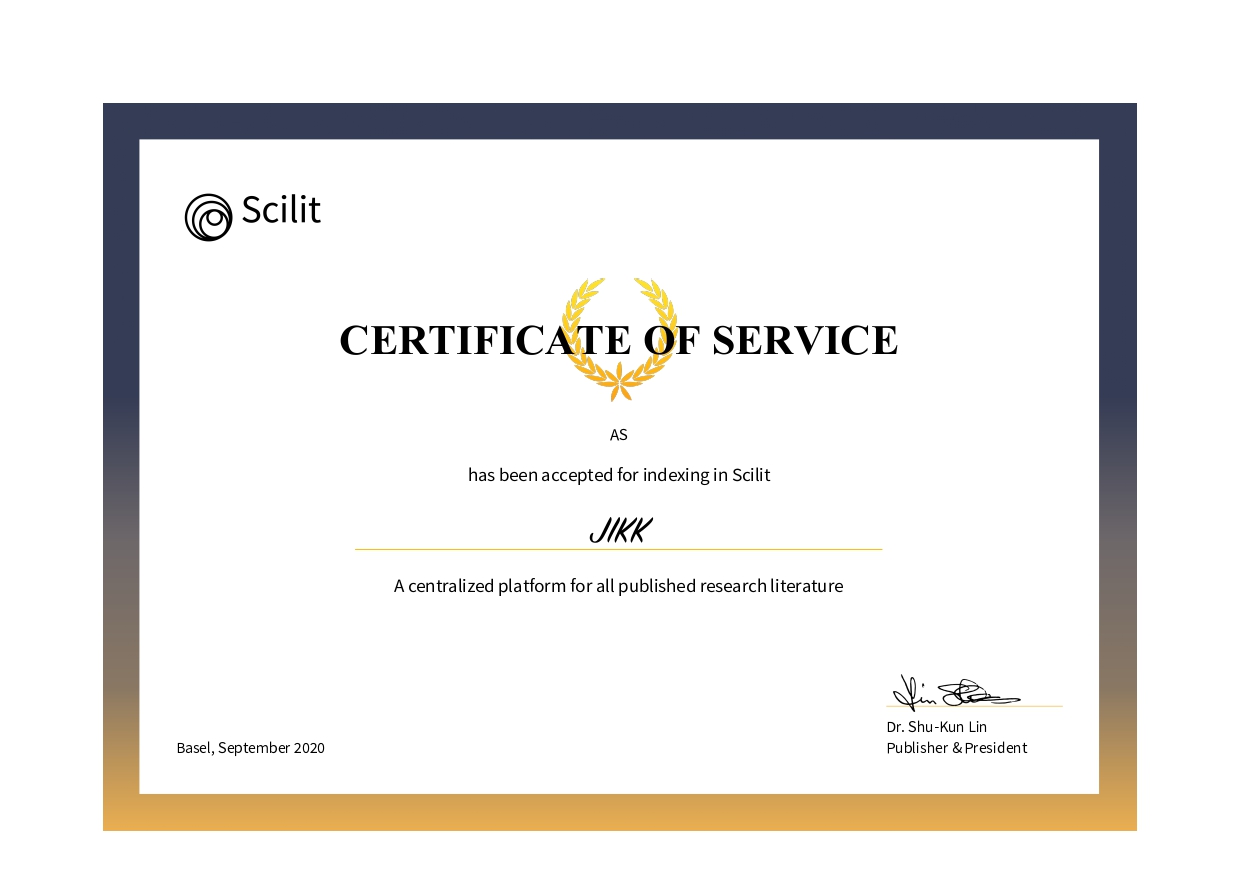EXPLAINING CHILDREN ON YOUTUBE: THE CASE OF INDONESIAN SUBSCRIBER BEHAVIORAL INTENTION ON KIDZ YOUTUBE CHANNEL
Kajian Anak pada YouTube: Kasus Minat Subscriber Indonesia di Channel Youtube Kidz
Abstract
Understanding children's behavior and intentions to subscribe to YouTube channels are important for production companies and parents. This study analyzed factors influencing children’s behavioral intention to subscribe to YouTube channels using UTAUT 2 model and SEM-PLS analysis. The samples were 100 kids aged 7 to 12 who live in the Greater Jakarta area. Data were collected through an online questionnaire. The results showed that habit and social influence significantly influenced children’s behavioral intention to use Kidz YouTube Channel. Children’s behavioral intention to use Kidz YouTube Channel significantly influenced children’s usage behavior. Moreover, children’s usage behavior significantly influenced their intention to subscribe to Kidz's YouTube Channel. The study indicated that children’s decision to subscribe to YouTube channels was simple and relied on their habits and social influence. Therefore, parents need to supervise children’s activities on YouTube. Meanwhile, the content creator company could optimize a routine schedule for uploading a new video based on selected themes and also needs to increase parents’ awareness of the safety of their program.
References
Atmojo, R., Nurhasan, M. B., Amanda, K. C., & Melissa, J. (2016). Penilaian penerimaan pengguna pada sistem manajemen pengetahuan dengan metoda UTAUT. ULTIMA InfoSys, 7(2), 65-74. https://doi.org/10.31937/si.v7i2.542
Brünink, L. (2016). Cross-functional big data integration: Applying the UTAUT model [Master’s thesis, University of Twente]. The University of Twente Student Theses. https://essay.utwente.nl/71098/
Bujizen, M., & Valkenburg, P. M. (2010). The impact of television advertising on children’s Christmas wishes. Journal of Broadcasting & Electronic Media, 44(3), 456-470. https://doi.org/10.1207/s15506878jobem4403_7
Chen, K. Y., & Chang, M. L. (2013). User acceptance of ‘near field communication’ mobile phone service: An investigation based on the ‘unified theory of acceptance and use of technology’ model. The Service Industries Journal, 33(6), 609-623. https://doi.org/10.1080/02642069.2011.622369
Chen, T. Y., & He, Q. Y. (2006). Applying decision tree techniques to segmentation bases for e-marketing. Management Science Research, 3(1), 1-25. https://doi.org/10.1108/10662241111139282
Cholifaturrosida, A. F., Mawardi, K., & Bafadhal, A. S. (2018). Pengaruh hedonic dan utilitarian motivation terhadap behavioral intention pada pemilihan tas mewah (Survei online terhadap konsumen wanita yang membeli tas mewah pada store urban icon di Surabaya). Jurnal Administrasi Bisnis, 55(2), 84-92. http://administrasibisnis.studentjournal.ub.ac.id/index.php/jab/article/view/2274
Genchev, E., & Todorova, G. (2017). Sales promotion activities – effective tool of marketing communication mix. Trakia Journal of Sciences, 15(1), 181-185. https://doi.org/10.2139/ssrn.3089894
Hassan, S. H., Ramayah, T., Mohamed, O., & Maghsoudi, A. (2015). E-lifestyle, customer satisfaction, and loyalty among the generation y mobile users. Asian Social Science, 11(4), 157-168. https://doi.org/0.5539/ass.v11n4p157
Helkkula, A. (2016). Consumers’ intentions to subscribe to music streaming services [Master’s thesis, Aalto University]. Aalto University Learning Centre. https://aaltodoc.aalto.fi/handle/123456789/20733
Indonesian Internet Service Users Association. (2018). Inforgrafis Penetrasi & Perilaku Pengguna Internet Indonesia [Penetration infographics and behavior of Indonesian internet service users]. https://apjii.or.id/downfile/file/surveipenetrasiinternet2018.pdf
Jati, N.J., & Laksito, H. (2012). Analisis faktor-faktor yang mempengaruhi minat pemanfaatan dan penggunaan sistem e-ticket. Diponegoro Journal of Accounting, 1(2), 1-15. https://ejournal3.undip.ac.id/index.php/accounting/article/view/562
Kaynak, E., & Kara, A. (2001). An examination of the relationship among consumer lifestyles, ethnocentrism, knowledge structures, attitudes, and behavioural tendencies: A comparative study in two CIS states. International Journal of Advertising, 20(4), 455-482. https://doi.org/10.1080/02650487.2001.11104906
Kusumawardhana, V., Anantadjaya, S. P. D., & Manurung, S. P. (2012). Gaya hidup, persepsi, dan intention to buy: Studi perilaku mahasiswa terhadap pemilihan jasa perbankan. Finance & Accounting Journal, 1(1), 49-66. http://digilib.mercubuana.ac.id/manager/t!@file_artikel_abstrak/Isi_Artikel_578515899454.pdf
Kurniawati, D., & Arifin, N. (2015). Strategi pemasaran melalui sosial media dan minat beli mahasiswa. Jurnal Simbolika, 1(2), 193-198. https://doi.org/0.31289/simbollika.v1i2.200
Labas, Y. N., & Yasmine, D. I. (2017). Komodifikasi di era masyarakat jejaring: Studi kasus YouTube Indonesia. Jurnal Pemikiran Sosiologi, 4(2), 104-119. https://doi.org/10.22146/jps.v4i2.28584
Livingstone, S., Haddon, L., Görzig, A. & Ólafsson, K. (2011). Risks and safety on the internet: The perspective of European children. Full findings. LSE, EU Kids Online. The London School of Economics and Political Science, London, UK. http://eprints.lse.ac.uk/33731/
Marhaeni, G. A. M. M. (2014). Analysis of the behavior of the use of instant messaging applications by using the model of unified theory of acceptance and use of technology 2 in Bandung City. Journal of E-Proceeding of Management, 1(3), 42-56. https://openlibrary.telkomuniversity.ac.id/home/epublication/id/26.html
Martins, C. I. (2013). Exploring digital music online: User acceptance and adoption of online music services [Doctoral dissertation, Universidade de Lisboa]. Universidade de Lisboa Repository. https://www.repository.utl.pt/handle/10400.5/5910?locale=en
Miladinovic, J., & Xiang, H. (2016). A study on factors affecting the behavioral intention to use mobile shopping fashion apps in Sweden [Master’s thesis, Jönköping University]. Jönköping University Library. http://hj.diva-portal.org/smash/record.jsf?pid=diva2%3A933382&dswid=-4358
Ofcom. (2018). Children and parents: Media use and attitudes report 2018. https://www.ofcom.org.uk/__data/assets/pdf_file/0020/108182/children-parents-media-use-attitudes-2017.pdf
Omar, S. Z., Daud, A., Hassan, M. S., Bolong, J., & Teimmouri, M. (2014). Children internet usage: OpportunitieAPJs for self development. Procedia – Social and Behavioral Sciences, 155(6), 75-80. https://doi.org/10.1016/j.sbspro.2014.10.259
Royal Children’s Health National Child Health Poll. (2017). Screen time and kids: What’s happening in our homes?. https://www.rchpoll.org.au/wp-content/uploads/2017/06/ACHP-Poll7_Detailed-Report-June21.pdf
Sarbani, Y. A., Astuti, E. S., & Kertahadi, K. (2013). Analysis of the use of information technology in school teaching staff (The study on teaching staff in schools belonging to the Dharmaputri association through the UTAUT model)]. Profit: Jurnal Administrasi Bisnis, 7(1), 168-181. https://profit.ub.ac.id/index.php/profit/article/view/312i
Suraputra, I. M. W., & Warmika, I. G. K. (2017). Pengaruh gaya hidup terhadap niat pembelian sepeda motor sport Honda yang dimediasi oleh sikap. E-Jurnal Manajemen, 6(1), 176-203. https://ojs.unud.ac.id/index.php/Manajemen/article/view/26572
Van der Heijden, H. (2004). User acceptance of hedonic information systems. MIS Quarterly, 28(4), 695-704. https://doi.org/ 10.2307/25148660
Venkatesh, V., & Davis, F. D. (2000). A theoretical extension of the Technology Acceptance Model: Four longitudinal field studies. Management Science, 46(2), 186-204. https://doi.org/10.1287/mnsc.46.2.186.11926
Venkatesh, V., Morris, M. G., Davis, G. B., & Davis, F. D. (2003). User acceptance of information technology: Toward a unified view. MIS Quarterly, 27(3), 425-478. https://doi.org/10.2307/30036540
Venkatesh, V., Thong, J. Y. L., & Xu, X. (2012). Consumer acceptance and use of information technology: Extending the unified theory of acceptance and use of technology. MIS Quarterly, 36(1), 157-178. https://doi.org/10.2307/41410412
Vinnick, V. (2017). User adoption of mobile applications: Extension of UTAUT2 model (Master’s thesis). NHH Brage. https://openaccess.nhh.no/nhh-xmlui/handle/11250/2487036?locale-attribute=no
Copyright (c) 2023 Jurnal Ilmu Keluarga & Konsumen

This work is licensed under a Creative Commons Attribution-ShareAlike 4.0 International License.
Authors submitting manuscripts should understand and agree that copyright of manuscripts published are held Jurnal Ilmu Keluarga dan Konsumen. The statement to release the copyright to Jurnal Ilmu Keluarga dan Konsumen is stated in Copyright Release Form. Copyright encompass exclusive rights to reproduce, to distribute, and to sell any part of the journal articles in all form and media. The reproduction of any part of this journal is allowed with a written permission from Jurnal Ilmu Keluarga dan Konsumen.









